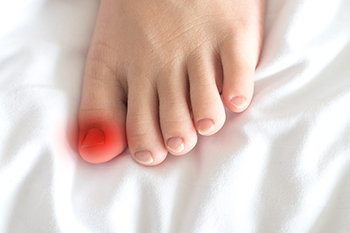
Ingrown toenails occur when the edge of a toenail grows into the surrounding skin, causing pain, redness, and sometimes infection. This common condition typically affects the big toe and can be caused by improper nail trimming, wearing tight shoes, or injury to the toe. Genetics can also play a role, as some people have nails that naturally curve inward. To treat an ingrown toenail, start by soaking the foot in warm water several times a day to reduce swelling and soften the skin. Gently lifting the edge of the nail and placing a small piece of cotton or dental floss underneath can help guide the nail to grow outward. Mild pain relievers and antibiotic ointments can also help to manage discomfort and prevent infection. Prevention involves trimming nails straight across, avoiding cutting them too short, and wearing properly fitting shoes. If the condition worsens or becomes infected, it is suggested that you visit a chiropodist who may need to perform a minor procedure for partial nail removal.
Ingrown toenails may require medical attention. If you have significant pain or notice signs of infection from an ingrown toenail, please consult with Paul A. Scotti, D.Ch from West Toronto Foot & Ankle Clinic Inc. . Our chiropodist will assess your condition and provide you with quality foot and ankle treatment.
What Is an Ingrown Toenail?
An ingrown toenail occurs when the edges of a toenail grow into the surrounding skin. The toenails of the big toe are usually affected, however, an ingrown toenail can happen on any toe. Sometimes, the area can become infected leading to potentially serious complications. The ingrown toenail may be caused by improper trimming of the toenail, wearing ill-fitting shoes, or injury to the nail.
Symptoms
The symptoms of an ingrown toenail include:
Pain
Swelling
Redness
Warmth
Pus or drainage from the affected nail or a fever may indicate an infection of the area.
Treatment
Treatment depends on the severity of the ingrown toenail. In less severe cases, home treatment may be adequate. Soaking the affected foot in warm water and gently lifting the nail from the skin with a piece of clean cotton can help. In more severe cases, you may need to use topical or oral antibiotics to treat an infection. Surgical removal of the ingrown toenail may be required if more conservative treatments fail.
Ingrown toenails may be prevented by wearing well-fitted shoes and properly trimming the toenails. Toenails should be trimmed straight across and not too short when using nail clippers.
If you have any questions, please feel free to contact our office located in . We offer the newest diagnostic and treatment technologies for all your foot care needs.
